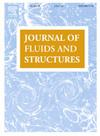稳定移动集中荷载下挠曲重力波和毛细重力波阻力的解析解
IF 3.5
2区 工程技术
Q1 ENGINEERING, MECHANICAL
引用次数: 0
摘要
本文分析研究了在两种不同密度的非混相流体界面上漂浮的弹性薄板上,集中载荷稳定运动所引起的界面弯曲重力波。假定这两种无粘流体是不可压缩和均匀的,运动是无旋的。将弹性力、压缩力和惯性力的运动方程嵌入到界面的动态边界条件中。基于小振幅波的线性势理论,用傅里叶变换导出了界面波剖面和波阻的积分解。明确地推导了色散关系和波数的精确解。研究发现,运动速度与最小相速之间的关系决定了波的动力特性。得到了压应力的最大允许值,在该值下,最小相速为零,由于板内存在压应力,载荷的任何非零移动速度都可以激发波的运动。探讨了抗弯刚度和流密度比的影响。通过抛弃本公式中的弹性力,可以很容易地恢复毛细管重力波的解。本文章由计算机程序翻译,如有差异,请以英文原文为准。
Analytical solutions for the flexural–gravity and capillary–gravity wave resistances due to a steadily moving concentrated load
The interfacial flexural–gravity waves due to a concentrated load steadily moving on the thin elastic plate floating on the interface between two immiscible fluids of different densities are investigated analytically. The two inviscid fluids are assumed to be incompressible and homogeneous, and the motion be irrotational. The equation of motion for the plate, including the elastic force, the compressive force and the inertial force, is imbedded in the dynamic boundary conditions on the interface. Based on the linear potential theory for small-amplitude waves, the integral solutions for the interfacial wave profiles and wave resistances are derived by the Fourier transform. The dispersion relation and the exact solutions for the wave numbers are explicitly deduced. It is found the wave dynamical behaviors depend on the relation between the moving speed and the minimal phase speed. The maximal allowable value for the compressive force is obtained, at which the minimal phase speed is zero and the wave motion can be stimulated with any nonzero moving speed of the load due to the presence of compressive stress in the plate. The effects of the flexural rigidity and the fluid density ratio are also explored. The solutions for the capillary–gravity wave can readily be recovered by discarding the elastic force in the present formulation.
求助全文
通过发布文献求助,成功后即可免费获取论文全文。
去求助
来源期刊

Journal of Fluids and Structures
工程技术-工程:机械
CiteScore
6.90
自引率
8.30%
发文量
173
审稿时长
65 days
期刊介绍:
The Journal of Fluids and Structures serves as a focal point and a forum for the exchange of ideas, for the many kinds of specialists and practitioners concerned with fluid–structure interactions and the dynamics of systems related thereto, in any field. One of its aims is to foster the cross–fertilization of ideas, methods and techniques in the various disciplines involved.
The journal publishes papers that present original and significant contributions on all aspects of the mechanical interactions between fluids and solids, regardless of scale.
 求助内容:
求助内容: 应助结果提醒方式:
应助结果提醒方式:


